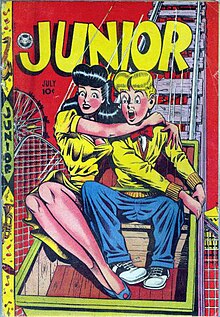
A cartoon is a type of visual art that is typically drawn, frequently animated, in an unrealistic or semi-realistic style. The specific meaning has evolved, but the modern usage usually refers to either: an image or series of images intended for satire, caricature, or humor; or a motion picture that relies on a sequence of illustrations for its animation. Someone who creates cartoons in the first sense is called a cartoonist, and in the second sense they are usually called an animator.
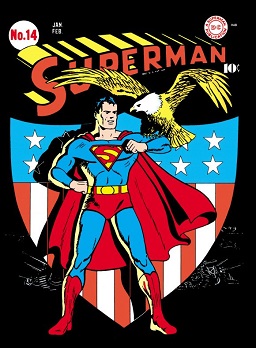
The Golden Age of Comic Books describes an era in the history of American comic books from 1938 to 1956. During this time, modern comic books were first published and rapidly increased in popularity. The superhero archetype was created and many well-known characters were introduced, including Superman, Batman, Robin, Captain Marvel, Captain America, and Wonder Woman.
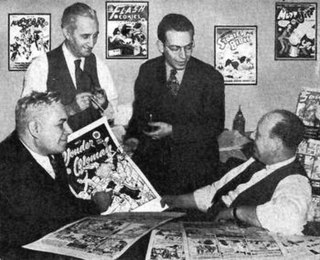
Maxwell Charles Gaines was a pioneering figure in the creation of the modern comic book.
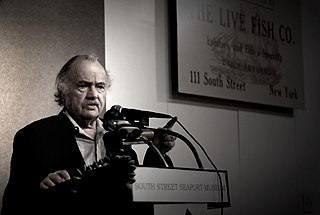
Ronald Joseph Goulart ( ) was an American popular culture historian and mystery, fantasy and science fiction author.

Robert Kane was an American comic book writer, animator and artist who co-created Batman and most early related characters for DC Comics. He was inducted into the comic book industry's Jack Kirby Hall of Fame in 1993 and into the Will Eisner Comic Book Hall of Fame in 1996.

An American comic book is a thin periodical originating in the United States, on average 32 pages, containing comics. While the form originated in 1933, American comic books first gained popularity after the 1938 publication of Action Comics, which included the debut of the superhero Superman. This was followed by a superhero boom that lasted until the end of World War II. After the war, while superheroes were marginalized, the comic book industry rapidly expanded and genres such as horror, crime, science fiction and romance became popular. The 1950s saw a gradual decline, due to a shift away from print media in the wake of television and the impact of the Comics Code Authority. The late 1950s and the 1960s saw a superhero revival and superheroes remained the dominant character archetype throughout the late 20th century into the 21st century.
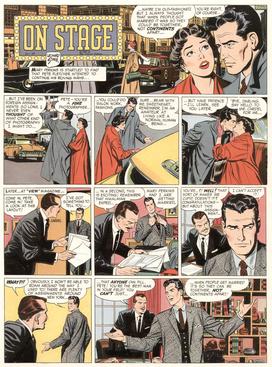
Mary Perkins, On Stage is an American newspaper comic strip by Leonard Starr for the Chicago Tribune-New York News Syndicate. It ran from February 10, 1957, to September 9, 1979, with the switch to the longer title in 1961. Some papers carried the strip under the shortened title Mary Perkins.
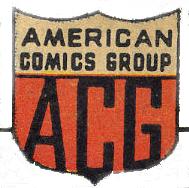
American Comics Group (ACG) was an American comic book publisher started in 1939 and existing under the ACG name from 1943 to 1967. It published the medium's first ongoing horror-comics title, Adventures into the Unknown. ACG's best-known character was the 1960s satirical-humor hero Herbie Popnecker, who starred for a time in Forbidden Worlds. Herbie would later get his own title and be turned into a "superhero" called the Fat Fury.
National Comics Publications, Inc. was an American comic book publishing company, and the direct predecessor of modern-day DC Comics.

The Funnies was the name of two American publications from Dell Publishing, the first of these a seminal 1920s precursor of comic books, and the second a standard 1930s comic book.

More Fun Comics, originally titled New Fun: The Big Comic Magazine a.k.a. New Fun Comics, was a 1935–1947 American comic book anthology that introduced several major superhero characters and was the first American comic book series to feature solely original material rather than reprints of newspaper comic strips. It was also the first publication of the company that would become DC Comics.

Major Malcolm Wheeler-Nicholson was an American pulp magazine writer and entrepreneur who pioneered the American comic book, publishing the first such periodical consisting solely of original material rather than reprints of newspaper comic strips. Historian and author David Hajdu credits Wheeler-Nicholson as "the link between the pulps and what we know of as comics today." And launching the magazine comics company National Allied Publications in 1934, which would evolve to become DC Comics. He was a 2008 Judges' Choice inductee into the Will Eisner Comic Book Hall of Fame.
Star Hawks was a comic strip created by Ron Goulart and Gil Kane, first published on October 3, 1977, that ran through May 2, 1981. It was written through April 1979 by Goulart, followed by Archie Goodwin (1979-1980), Roger McKenzie (1980-1981) and Roger Stern. Comics veteran Gil Kane provided the artwork, with uncredited help from Ernie Colón and Howard Chaykin.

Blue Ribbon Comics is the name of two American comic book anthology series, the first published by the Archie Comics predecessor MLJ Magazines Inc., commonly known as MLJ Comics, from 1939 to 1942, during the Golden Age of Comic Books. The revival was the second comic published in the 1980s by Archie Comics under the Red Circle and Archie Adventure Series banners.
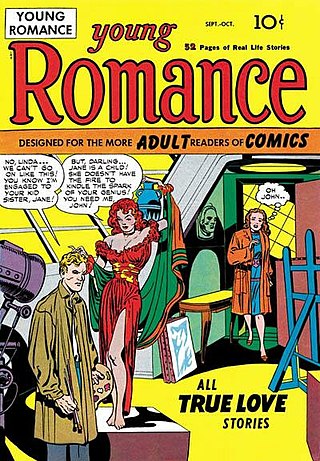
Romance comics are a genre of comic books that were most popular during the Golden Age of Comics. The market for comics, which had been growing rapidly throughout the 1940s, began to plummet after the end of World War II when military contracts to provide disposable reading matter to servicemen ended. This left many comic creators seeking new markets. The romance comic genre was created by Joe Simon and Jack Kirby, who kicked off Young Romance in 1947 in an effort to tap into new adult audiences. In the next 30 years, over 200 issues of the flagship romance comic would be produced.
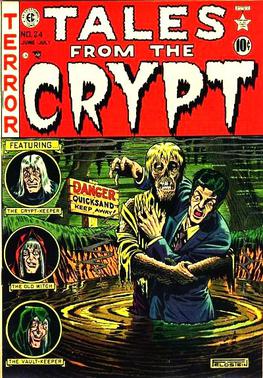
Horror comics are comic books, graphic novels, black-and-white comics magazines, and manga focusing on horror fiction. In the US market, horror comic books reached a peak in the late 1940s through the mid-1950s, when concern over content and the imposition of the self-censorship Comics Code Authority contributed to the demise of many titles and the toning down of others. Black-and-white horror-comics magazines, which did not fall under the Code, flourished from the mid-1960s through the early 1980s from a variety of publishers. Mainstream American color comic books experienced a horror resurgence in the 1970s, following a loosening of the Code. While the genre has had greater and lesser periods of popularity, it occupies a firm niche in comics as of the 2010s.
Comics studies is an academic field that focuses on comics and sequential art. Although comics and graphic novels have been generally dismissed as less relevant pop culture texts, scholars in fields such as semiotics, aesthetics, sociology, composition studies and cultural studies are now re-considering comics and graphic novels as complex texts deserving of serious scholarly study.
Superkatt is an American cartoon animal comic book series by Dan Gordon, a jab at the “long-underwear” genre of superhero comics. The series stars Superkatt, an anthropomorphic cat who wears a bowtie, bonnet, and diaper as a superhero costume. Ron Goulart, author of Ron Goulart's Great History of Comic Books, said that Superkatt was Dang's most memorable comic book character. Denis Gifford, author of The International Book of Comics, said that the character "was as silly as his supercostume."
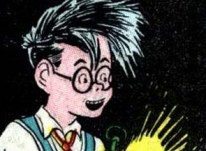
Scribbly the Boy Cartoonist is a comic book character created in 1936 by Sheldon Mayer, first appearing in Dell Comics and then moving to All-American Publications. Scribbly Jibbet is a semi-autobiographical character, presenting the adventures of a young man starting out in the cartooning business, and working for the Morning Dispatch newspaper. His stories were told around the Golden Age era, when American Comic Books were primarily anthologies telling more than one story in a magazine issue. Scribbly first appeared in the Popular Comics series, and then appeared in All-American Comics from 1939 to 1944. He was then revived in his own series, Scribbly, from 1948 to 1952.
Maurice Horn was a French-American comics historian, author, and editor, considered to be one of the first serious academics to study comics. He was the editor of The World Encyclopedia of Comics, The World Encyclopedia of Cartoons, and 100 Years of American Newspaper Comics. Born in France, he was based in New York City. Horn died on December 30, 2022, at the age of 91.
